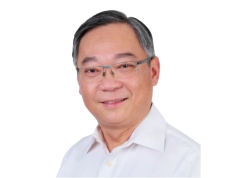Schroders Strategist Tina Fong: Why This Economic Cycle is Different?
November 2022 – This is an expert commentary on the global economy – Why this economic cycle is different? by Tina Fong who is the Strategist at Schroders.
 Schroders is a global active asset manager managing more than £574.4 billion (€641.7 billion / $785.1 billion 31/12/20) assets and managed locally by 42 investment teams worldwide. As a global active asset manager, the way we direct capital not only shapes the financial returns we achieve for our clients but also the impact that the companies in which we invest on their behalf might have on society.
Schroders is a global active asset manager managing more than £574.4 billion (€641.7 billion / $785.1 billion 31/12/20) assets and managed locally by 42 investment teams worldwide. As a global active asset manager, the way we direct capital not only shapes the financial returns we achieve for our clients but also the impact that the companies in which we invest on their behalf might have on society.
Why This Economic Cycle is Different?
Unique circumstances mean there are no clear-cut lessons from history, making this economic cycle particularly hard to categorise.

Tina Fong:. No two economic cycles are the same but as the American writer Mark Twain eloquently put it “history doesn’t repeat itself, but it often rhymes”. This cycle is proving to be particularly different, however, which makes it even more challenging to draw parallels with the past.
Depending on which indicators you look at, the US economy could be categorised as being in any one of the business cycle’s four phases. These are expansion, slowdown, recession and recovery. If we use the textbook definition of recession – two consecutive quarters of negative real GDP growth – the US is in one. Recessions, however, are usually accompanied by a meaningful pick-up in the unemployment rate, and this has not occurred.
” the unemployment rate is at a multi-decade low “
Instead, the unemployment rate is at a multi-decade low. Indeed, the strength of the labour market speaks of an economy in its expansion phase, albeit now clearly pushing at capacity limits. Other economic indicators, however, such as business surveys (deteriorating) and the rate of change in inflation (still accelerating), suggest an economy already experiencing that particularly difficult type of slowdown, stagflation. Certainly, the sharp de-rating of US equities seen this year is in keeping with stagflation.
In short, this economic cycle can’t be easily categorised.
1) Unique circumstances have created 2-speed economy

Tina Fong: As the rapid pace of rate rises by the Federal Reserve (Fed) continue to take effect, we expect economic indicators to become less contradictory. This should occur in 2023 when we anticipate the US economy to be in a recession (see: Why recession looms for the developed world).
” This should occur in 2023 when we anticipate the US economy to be in a recession “
Since the post-war period, every time there has been two consecutive quarters of negative real GDP growth, recession has been confirmed by the NBER (National Bureau of Economic Research). The NBER is the official authority on dating US recessions based on monitoring a variety of macro-economic indicators. So far, they have not announced recession. The weakness in Q2 2022 GDP was also distorted by a significant fall in inventories after strong stockpiling in previous quarters. So, it seems premature to call the end of the cycle based on recent disappointing GDP releases.
Schroders NBER Recessions Chart:

Tina Fong: In contrast, the Schroders Output Gap model, which measures the amount of spare capacity in the economy, suggests that the US economic cycle remains in the expansion phase (see chart 2, below). This is because the output gap is positive and rising.
” the maximum level of output an economy can produce without generating inflation “
The output gap is the difference between an economy’s actual output and its potential output, a positive output gap suggests the economy is running out of spare capacity, which adds to inflationary pressures. Ordinarily, monetary policy would be tightened at this stage to bring actual output back to its potential (the maximum level of output an economy can produce without generating inflation). The Fed is currently attempting to engineer just this. As activity slows down, the positive gap begins to shrink, and the economy enters the slowdown phase – although this is not yet occurring following a blistering pace of interest rate rises.
Schroders Output Gap model and phases of the economic cycle
- Expansion – output gap is positive and rising
- Slowdown – output gap is positive and falling
- Recession – output gap is negative and falling
- Recovery – output gap is negative and rising
Schroders Output Gap Model:

Tina Fong: Instead, a presently positive and rising output gap reflects labour market strength, as captured by the ‘unemployment gap’. The unemployment gap is one of the key inputs into the output gap model and tells us if there are less unemployed workers compared to trend levels. Monetary policymakers make a judgement on what is the NAIRU (Non-Accelerating Inflation Rate of Unemployment), being the lowest level of unemployment that can be achieved before inflation begins to rise in the economy.
So, there will need to be a meaningful rise in the unemployment rate before the positive and rising output gap begins to shrink.
Schroders Unemployment Rate Vs NAIRU Non-Accelerating Inflation Rate of Unemployment:
2) US economy & markets showing more late cycle traits

Tina Fong: While we expect our output gap model to move into slowdown at the start of 2023, we recognise that other areas of the US economy are already showing late cycle characteristics. Growth momentum has peaked, and business surveys have eased while inflation has accelerated.
” the magnitude of equity losses this time around has been greater compared to past slowdowns “
Even the particularly poor performance of markets is typical of a stagflationary environment. The performance of the S&P 500 year-to-date (YTD) is more consistent with past slowdowns as defined by our output gap model. Equities typically suffer during slowdowns as corporate profitability gets hit by weaker growth and rising costs from higher wages and interest rates. But the magnitude of equity losses this time around has been greater compared to past slowdowns. Despite robust corporate earnings, valuations have significantly de-rerated. This is because the high levels of inflation have led to more aggressive expectations of policy tightening by the Fed.
3) This cycle is proving rather different

Tina Fong: We’re in rather unusual circumstances in that the contraction in economic activity in 2022 has come after a very sharp recovery in growth from Covid-19 lockdowns. So, macro data has eased back to more normal levels. At the same time, US inflation at 8.5% is usually high relative to past cycles. This has led to comparisons with the stagflationary period of the 1970s as inflation back then surged to record levels prompted by an oil price shock.
” the imbalance between supply and demand for goods, resulting from the Covid-19 pandemic, is the root cause of inflation in this cycle “
Unlike the 1970s, the imbalance between supply and demand for goods, resulting from the Covid-19 pandemic, is the root cause of inflation in this cycle (see: Three reasons inflation isn’t going away anytime soon). This has been further exacerbated by the Ukraine-Russia war and the impact on supply chains resulting from China’s zero-Covid policy. So, it is not straightforward to draw parallels with the 1970s, particularly given the robust labour market. The tightness in the labour market has also been driven by factors resulting from the pandemic. In particular, the decline in the number of workers participating in the labour force.
- Firstly, more people in the older cohorts have decided to take up early retirement due to health concerns.
- Secondly, some workers have chosen to exit the labour force due to a reassessment of priorities such as caring for relatives.
- Thirdly, long Covid has hit the workforce and according to the Brookings Institute accounts for 15% of 10.6 million unfilled jobs in the US (see here).
Some of these factors could ease over time as higher wages incentivise workers to return to the labour force. But more importantly, the tightening in monetary policy by the Fed to bring inflation back to target should result in a more significant slowdown in growth (see: Forget soft landings – how much of a recession is needed to tame inflation?) and a rise in the unemployment rate. This would lead to a return to a more normal economic cycle.
4) Semblance of normality to return, but not quite yet

Tina Fong: We expect some semblance of a normal cycle return in the coming quarters as the US economy goes into recession. Not only would GDP growth be likely to contract, but the pick-up in the unemployment rate would first lead to the output gap shrinking, then turning negative. Inflation should also have eased from lofty levels.
For investors, it would mean a return to more familiar territory where equities offer attractive valuation opportunities in recessions. At the same time, despite dismal corporate earnings, US stocks have typically been lifted by the re-rating in the market. This occurs thanks to the central bank cutting interest rates in response to the worsening growth and inflation landscape. We saw with the rally in the summer of 2022 how investors (prematurely) anticipated a Fed ‘pivot’ to a less restrictive policy stance, in support of economic growth and its second mandate of maximum employment. This drove a powerful re-rating, which abruptly reversed when Fed chairman Jerome Powell dashed hopes of a looser near-term policy.
” Fed pivot toward the end of 2023 as policy is likely to be eased to counter the impact from a recession “
He warned that the central bank would ‘keep at it’ in relation to raising interest rates. We do, however, expect there to be scope for a Fed pivot toward the end of 2023 as policy is likely to be eased to counter the impact from a recession.
This is an expert commentary on global economy by Tina Fong, who is the Strategist at Schroders.
Important Information
This document is intended to be for information purposes only and it is not intended as promotional material in any respect nor is it to be construed as any solicitation and offering to buy or sell any investment products. The views and opinions contained herein are those of the author(s), and do not necessarily represent views expressed or reflected in other Schroders communications, strategies or funds. The material is not intended to provide, and should not be relied on for investment advice or recommendation. Any security(ies) mentioned above is for illustrative purpose only, not a recommendation to invest or divest. Opinions stated are valid as of the date of this document and are subject to change without notice. Information herein and information from third party are believed to be reliable, but Schroder Investment Management (Hong Kong) Limited does not warrant its completeness or accuracy.
Investment involves risks. Past performance and any forecasts are not necessarily a guide to future or likely performance. You should remember that the value of investments can go down as well as up and is not guaranteed. You may not get back the full amount invested. Derivatives carry a high degree of risk. Exchange rate changes may cause the value of the overseas investments to rise or fall. If investment returns are not denominated in HKD/USD, US/HK dollar-based investors are exposed to exchange rate fluctuations. Please refer to the relevant offering document including the risk factors for further details.
This material has not been reviewed by the SFC. Issued by Schroder Investment Management (Hong Kong) Limited. Schroder Investment Management (Hong Kong) Limited Level 33, Two Pacific Place, 88 Queensway, Hong Kong www.schroders.com.hk
About Schroders
As a global active asset manager, the way we direct capital not only shapes the financial returns we achieve for our clients but also the impact that the companies in which we invest on their behalf might have on society. The relationship between these two outcomes has rapidly evolved as we see a fundamental shift in how companies are viewed and valued. Understanding the impact that they can have on society and the planet is crucial in assessing their ability to deliver risk-adjusted profits.
Our ongoing success is built on a history of experience and expertise, whereby we partner with our clients to construct innovative products and solutions across our five business areas consisting of Private Assets & Alternatives, Solutions, Mutual Funds, Institutional and Wealth Management and invest in a wide range of assets and geographies. By combining our commitment to active management and focus on sustainability, our strategic capabilities are designed to deliver positive outcomes for our clients. We are responsible for £574.4 billion (€641.7 billion/$785.1 billion 31/12/20) assets of our clients, managed locally by 42 investment teams worldwide. As a global business with over 5,500 talented staff across 35 locations, we are able to stay close to our clients and understand their needs. We have over 200 years of experience in investment and innovation. Visit: www.schroders.com.hk
Sign Up / Register
Caproasia Users
- Manage $20 million to $3 billion of assets
- Invest $3 million to $300 million
- Advise institutions, billionaires, UHNWs & HNWs
Caproasia Platforms | 11,000 Investors & Advisors
- Caproasia.com
- Caproasia Access
- Caproasia Events
- The Financial Centre | Find Services
- Membership
- Family Office Circle
- Professional Investor Circle
- Investor Relations Network
Monthly Roundtable & Networking
Family Office Programs
The 2025 Investment Day
- March - Hong Kong
- March - Singapore
- July - Hong Kong
- July - Singapore
- Sept- Hong Kong
- Sept - Singapore
- Oct- Hong Kong
- Nov - Singapore
- Visit: The Investment Day | Register: Click here
Caproasia Summits
- The Institutional Investor Summit
- The Investment / Alternatives Summit
- The Private Wealth Summit
- The Family Office Summit
- The CEO & Entrepreneur Summit
- The Capital Markets Summit
- The ESG / Sustainable Investment Summit



























